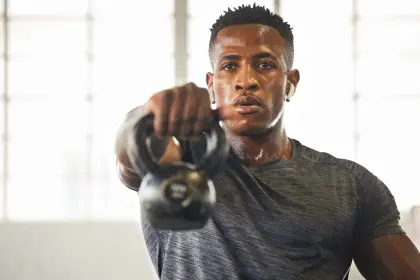Remember when your high school gym teacher made everyone touch their toes before running laps? Turns out, they might have been leading you astray all along. That pre-workout stretching ritual you’ve been faithfully performing might not be the injury-prevention miracle it’s been made out to be.
For decades, static stretching before exercise has been fitness gospel, as fundamental as tying your shoelaces before a run. But emerging research and elite athletic practices are turning this conventional wisdom on its head. Your stretching routine might be due for a serious update, and the reasons why might surprise you.
The static stretching myth
Picture this. You arrive at the gym, roll out your mat, and immediately reach for your toes, holding the position while counting to 30. This type of stretching, where you hold a stretch in a fixed position, is called static stretching. And while it feels productive, it might actually be counterproductive right before you start pumping iron or hitting the treadmill.
Static stretching temporarily decreases muscle power and strength when done immediately before an activity. It’s like trying to shoot a rubber band that’s already been stretched out—it simply doesn’t have the same pop. Studies have found that pre-workout static stretching can reduce muscle strength by up to 30% and explosive muscle performance by up to 8%.
For runners, cyclists, weightlifters, and other athletes whose activities require power and strength, this reduction could not only hinder performance but potentially increase injury risk when your muscles can’t respond optimally to demands.
When your nervous system gets confused
Your body isn’t just a collection of muscles and bones; it’s a complex system where your brain and nervous system constantly communicate with your muscles. Static stretching essentially tells your nervous system to relax and reduce tension in a muscle.
The problem? Right after stretching, you’re about to ask those same muscles to contract forcefully and generate power. It’s like telling someone to go to sleep and then immediately expecting them to sprint—you’re sending mixed messages to your body.
This neurological confusion can leave you in a suboptimal state for exercise, especially for activities requiring quick reactions or explosive movements. Your muscles might be more flexible, but they’re also temporarily less responsive.
The temperature factor
Think of your muscles like taffy. When cold, they’re stiff and prone to tearing. When warm, they’re pliable and resilient. Effective workout preparation isn’t about stretching cold muscles; it’s about warming them up from the inside out.
Static stretching doesn’t effectively increase muscle temperature. In fact, standing still while stretching might even allow your body temperature to drop, especially in cooler environments. This could leave you more vulnerable to strains and sprains when you suddenly ask those cold muscles to work.
A proper warm-up should literally warm your tissues by increasing blood flow, raising muscle temperature, and preparing the energy systems you’re about to use. Light cardio that mimics the movements of your upcoming workout accomplishes this far better than static holds ever could.
The mobility-stability balance
Your body craves the right balance between mobility and stability. Mobility is your ability to move freely through a range of motion. Stability is your ability to control and protect your joints during that movement. Both are essential, but their importance varies depending on the joint.
Some joints, like your hips and shoulders, naturally prioritize mobility. Others, like your knees and lower back, prioritize stability. Pre-workout static stretching often ignores this distinction, potentially compromising stability in joints that need it most.
Excessive stretching of already mobile areas, or forcing mobility in naturally stable joints, can disrupt this delicate balance. This disruption might leave you more vulnerable during your workout, not less.
The timing mistake
If static stretching isn’t the answer before a workout, does that mean it’s worthless? Absolutely not. The issue isn’t the stretching itself—it’s when you’re doing it.
Static stretching has significant benefits when performed after exercise or as its own separate session. This is when your muscles are already warm, making them more receptive to stretching. More importantly, you’re not about to ask them to generate force immediately afterward.
Post-workout is the perfect time to improve your flexibility and range of motion, when your muscles are warm and fatigued. This timing allows you to capture the flexibility benefits without compromising your workout performance or safety.
The dynamic alternative
So if static stretching before a workout is out, what should you do instead? The answer is dynamic movement preparation—sometimes called a dynamic warm-up.
Dynamic movements are controlled exercises that move your joints through their full range of motion, increasing blood flow, raising body temperature, and activating the nervous system. Think leg swings, arm circles, bodyweight squats, and walking lunges.
These movements prepare your body for activity by rehearsing the motions you’re about to perform, but in a less intense manner. They bridge the gap between rest and exertion, allowing your body to gradually ramp up rather than going from 0 to 100 instantly.
The individualized approach
Perhaps the biggest problem with the traditional stretching dogma is that it’s one-size-fits-all. Your body’s needs are unique, based on your structure, history, and the activities you’re about to perform.
Some bodies do benefit from specific stretches before activity, particularly if you have identified tight areas that restrict proper movement patterns. The key is understanding your own body’s needs rather than following generic advice.
A baseball pitcher might benefit from specific shoulder mobility work before throwing, while a cyclist might need hip flexor movements before hopping on the bike. The most effective approach is always personalized, addressing your specific limitations and the demands of your sport.
The science of workout preparation continues to evolve, challenging long-held beliefs about stretching. Rather than clinging to outdated practices, embrace a more nuanced approach that prepares your body effectively for the specific demands you’re about to place on it.
The next time you head to the gym, consider skipping the toe-touches and instead engage in movement that gradually elevates your heart rate and rehearses the patterns you’re about to perform. Your performance may improve, and your body will thank you.

















